Battle of Tientsin
| Battle of Tientsin | |||||||
|---|---|---|---|---|---|---|---|
| Part of the Boxer Rebellion | |||||||
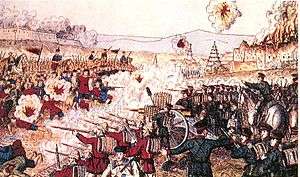 British and Japanese forces engage Boxers in battle. | |||||||
| |||||||
| Belligerents | |||||||
|
|
| ||||||
| Commanders and leaders | |||||||
|
|
| ||||||
| Strength | |||||||
| 6,900 |
| ||||||
| Casualties and losses | |||||||
| 250 killed, 500 wounded. | Unknown, but likely heavy | ||||||
The Battle of Tientsin, or the Relief of Tientsin, occurred on July 13–14, 1900, during the Boxer Rebellion in Northern China. A multinational military force, representing the Eight-Nation Alliance, rescued a besieged population of foreign nationals in the city of Tientsin (Pinyin: Tianjin) by defeating the Chinese Imperial army and Boxers. The capture of Tientsin gave the Eight-Nation Alliance a base to launch a rescue mission for the foreign nationals besieged in the Legation Quarter of Peking (Pinyin: Beijing).
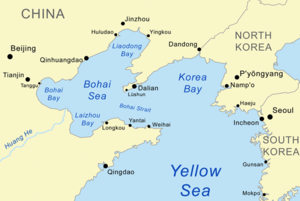
Background
Tientsin, in 1900, consisted of two adjacent, but very different sub-divisions. To the northwest was the ancient high-walled Chinese city, one mile (1.6 km) on each side. To the southeast, one to two miles away (3 km), along the Hai River, was the treaty port and foreign settlements, a half-mile wide (1 km).[2] About one million Chinese lived within the walled city or in satellite communities outside the wall. In the foreign settlements resided 700 foreign civilians, mostly European merchants and missionaries, along with tens of thousands of Chinese servants, employees, and businessmen. Among the civilians living in the foreign settlement were Herbert Hoover, a future president of the United States, and his wife Lou Henry Hoover. A low mud wall, less than 10 ft tall (3.0 m), surrounded at a distance of several hundred yards (half km) both the higher walls of the old city and the foreign settlements.[3]
In early June 1900, in response to the growing threat of the Boxers (Militia United in Righteousness, Yihetuan), which was a militant, anti-foreign and anti-Christian peasant movement, six countries with interests in China sent 2,400 troops to Tientsin to guard the foreign settlements. Another 2,000 were with Admiral Seymour along the railway line between Tientsin and Peking, attempting to march to Peking to protect the foreign community there. The allied military force was composed of soldiers, sailors, and marines from Great Britain, the United States, Japan, France, Russia and Germany. Italy and Austria-Hungary were members of the Eight-Nation Alliance but had only a few soldiers in China. With so many nationalities among the Allied force, no overall commander was appointed. Leadership was collective.
The Siege

Thousands of Boxers from the countryside converged upon Tientsin, and on June 15, 1900, they rampaged through the walled city destroying Christian churches and killing Chinese Christians. On June 16, a mob of partially armed Boxers advanced on the foreign settlement. They were driven off by volleys of fire from the defenders.[4] The Chinese army near Tientsin stood by and awaited orders from Peking to either support the Boxers or protect the foreigners. As a result of the June 17 attack by the foreign armies on the Dagu Forts, the Qing government of China took the side of the Boxers and ordered the army to attack the foreign settlements. The Chinese began bombarding the foreign settlement with artillery on June 17. The Western and Japanese soldiers defending the foreign settlements were initially stretched thin, and all communication with the coast and the allied fleet was cut off for several days.[5]
The Chinese army numbered an estimated 15,000 in Tientsin plus Boxers armed with swords, spears, and antique guns, although the number of Boxer combatants was diminishing rapidly as the movement was fading back into the countryside from where it came. The army were led by general Nieh Shih-ch'eng, who was considered one of the ablest Chinese officers. Most of the Chinese army action against the foreign settlements consisted of a daily artillery barrage. The army fired an estimated 60,000 artillery shells at the foreign settlements. However, most of the shells failed to explode on impact due to inefficiency and corruption in the Chinese ammunition factories and did less damage that might otherwise have been expected.[6]
On June 21, 1900, some 131 US Marines and 400 Russians made a desperate attempt to reinforce Tientsin by following the railway from the coast to the city. Only two miles from the city they were ambushed by the Chinese and forced to retire, the Americans losing 3 killed and 13 wounded.[7][8] Additional Western soldiers were unloaded from ships offshore and rushed up the railroad to Tientsin. Five thousand reinforcements reached Tientsin on June 23 to augment the hard-pressed soldiers and civilians defending the foreign settlements. Their arrival caused the Chinese to withdraw from their position on the east which enabled the besieged to establish a tenuous line of communication and supply along the railroad to the coast, 30 miles (48 km) away. The Chinese army continued to besiege three sides of the Tientsin foreign settlements.[9] On June 26, a force of 2,000 sallied from the settlements and rescued Admiral Seymour and his 2,000 men who were surrounded six miles (10 km) out of the city. With Seymour's men they returned to the settlements without opposition. Most of Seymour's force of sailors returned to their ships. Reinforced, and with their supply line to the coast secured, the coalition of allied soldiers in the foreign settlement began planning an assault on the walled city of Tientsin to defeat the Chinese army and open the road to Peking and the relief of the Siege of the International Legations.[10]
Nie Shicheng and Ma Yukun commanded the forces against the Alliance, raining precise and intense ordnance against the Tientsin concessions.[11] The losses suffered by the Alliance in battle was mainly due to artillery bombardment since the Chinese army carried it out with extreme precision and in a superb manner. They hid well, employed good bulwarks of defense by utilizing the landscape and went on the offensive in a dauntless manner and would continue battling until the end.[12]
The battle
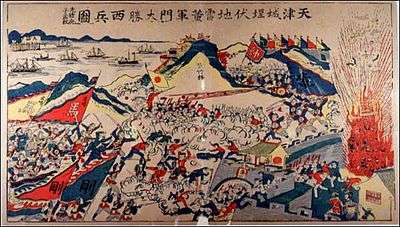
The allies had underestimated the capability of the Chinese forces at the beginning of the siege, thinking that foreign troops could easily brush aside Chinese forces. They turned out to be wrong, in the face of fierce Chinese resistance.[2] On July 13, 1900, the allied force to assault the walled city of Tientsin consisted of about 6,900 soldiers: 2,500 Russians, 2,000 Japanese, 900 Americans, 800 British, 600 French, and 100 Germans and Austrians.[13] The challenge was substantial. The walls of Tientsin were 20 feet high and 16 feet thick (6 m high and 5 m thick). The Chinese had about 12,000 soldiers within the city or in nearby forts. They were armed with both artillery, machine guns, and modern rifles. To reach the city wall, the allied troops would have to cross more than a mile (2 km) of flat, unwooded terrain, dotted with farmhouses and swamps and crossed by canals and causeways.[14] An American soldier surveying the scene said that "had a formidable enemy defended the Chinese position the attacking column would have been annihilated."[15]
The plan of the allies was to storm the city on two sides: British, American, Japanese and French troops would attack the South Gate; Russian and German troops would attack the East Gate. Herbert Hoover, who was based in the city as a mining engineer, agreed to guide the Allied forces through the local terrain. Early in the morning of 13 June 13, 1900, Hoover with the US Marines guided the three columns of British, American, Japanese and French troops to the approaches to the South Gate. When the lead troops came under fire, Hoover was permitted to withdraw from the action and return to Tientsin where the civilian population was waiting to be evacuated to the Taku (Dagu) Forts. However, Hoover and his wife, Lou Henry Hoover, remained in Tientsin to care for the wounded.[16]
The attack went poorly for the Allies in large part due to the lack of overall command. Miscommunication and uncoordinated movements plagued the attackers. The main effort against the South Gate became pinned down in an exposed position under Chinese fire from within the city. The Chinese again unleashed a torrent of fire upon the Allies. The allied troops were forced to lie face down in mud. The uniform of the American troops, dark blue, provided a virtual bulls eye to the Chinese troops, equipped with western firearms, such as Winchesters, Mausers, Mannlichers.[17] Severe losses were inflicted on the Allies. Captain David Beatty noted the British forces took cover in an entirely exposed location. Similarly, some men of the 9th U.S. Infantry Regiment were exposed to Chinese fire and Colonel Emerson H. Liscum of the regiment was mortally wounded. His dying words were, "Keep up the fire!" The allied troops were held down in the mud by the constant Chinese fire.[18] Herbert Hoover led American Marines to assist the Royal Welsh Fusiliers, and they hit a swamp where Chinese guns murderously targeted them. The Chinese kept the guns firing for over five hours, until nightfall. Bullets were described as "hail", and guns provided a "death tattoo".[19]

The Japanese General Fukushima Yasumasa, who had fought against Chinese previously, warned Allied commander Dorwood that Chinese forces would fight to the death if trapped, but if they left an escape route of two gates open, the Chinese would retreat.[20]
Eventually the attacks were called off. The Japanese soldiers attempted to blast away the South Gate but the defenders continued to simply cut or extinguish the fuses. Finally at 3:00am the following morning the Japanese army met with success. A soldier volunteered to brave enemy fire and light a short fuse. The soldier was killed in the explosion but the gate was open. Japanese soldiers poured through the open gate followed by the British and Americans. The Russians renewed their attack on the East Gate and finally broke through. The Chinese defenders made good their escape in the face of this recent Allied success, but minus General Nieh Shih-ch'eng, who was killed in the fighting. Once inside the city the Allies once again became disorganized and many soldiers turned to looting. As the Imperial Chinese soldiers had already withdrawn it was the local Chinese who suffered the most and many of these civilians were killed.
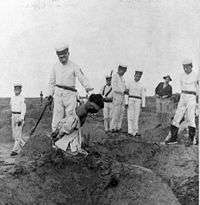
Allied troops raped women. The Germans and Russians were reported to have behaved savagely and bayoneted their rape victims. The Allies covered up their atrocities by labeling all Chinese dead as Boxers. The Japanese were acclaimed to be the best behaved of the foreign soldiers. A Japanese officer expressed shock at the atrocities committed by the other foreign troops.[21] After General Nie was killed and Generals Ma and Song retreated, only Dong Fuxiang remained with his Muslim troops to contest the advance of the foreign army from Tientsin to Peking.[22]
Casualties
For the Eight-Nation Alliance, Tientsin was the bloodiest battle of the Boxer Rebellion. Two hundred and fifty soldiers of the allied armies were killed and about 500 wounded. The Japanese lost 320 killed and wounded; the Russians and Germans 140 killed and wounded; the Americans 25 killed, and 98 wounded; the British, 17 killed and 87 wounded; and the French 13 killed and 50 wounded. Chinese casualties, military and civilian, are unknown, but probably heavy.[23]
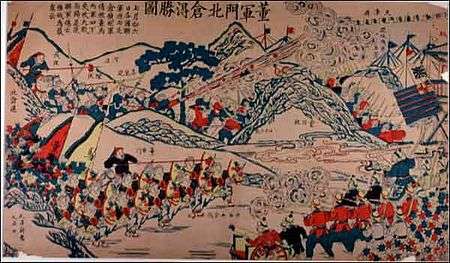
Aftermath
After the victory at Tientsin, the foreign soldiers decided that the advance on Peking should be delayed until sufficient forces were collected. This was largely on account of the changed opinions regarding Chinese valor and the effectiveness of their resistance to the Seymour expedition. As it was, the Allies would have tarried at Tientsin for additional reinforcements some weeks longer had not the British and American commanders threatened to proceed alone with their contingents and risk the consequences. Although it was felt, so had the estimation of Chinese prowess been increased, that at least 50,000 troops were necessary, some thought 70,000, successfully to invade the interior, the second relief expedition to Peking finally got under way, August 4, with an impressive total of 18,800 men. This number included 8,000 Japanese, 3,000 British, 4,500 Russians, 2,500 Americans, and 800 French. The Germans were unrepresented, as it was judged best to reserve some strength for Kiaochau and the coast, in case of trouble there.
Monument
In the Nankai District of Tianjin in present-day China, a "Nie Shicheng Martyrs Monument" is located in the area, to General Nie Shicheng who died in battle at the Battle of Tientsin.[24]
See also
Sources
- ↑ https://archive.org/stream/bronzetabletsere00mili#page/2/mode/2up
- 1 2 Arthur Henderson Smith (2014) [1901]. China in Convulsion. Volume 2. F. H. Revell Co. p. 444 of 770. ISBN 978-1295556298. Retrieved 2010-06-28.
- ↑ Thompson, Larry Clinton. William Scott Ament and the Boxer Rebellion: Heroism, Hubris, and the Ideal Missionary. Jefferson, NC: McFarland, 1909, p. 98 books.google.com
- ↑ Preston, Diana. The Boxer Rebellion: The Dramatic Story of China's War on Foreigners that Shook the World in the Summer of 1900. New York: Berkley Books, January 2001, p. 107.
- ↑ Thompson, pp. 98–100
- ↑ Robert B. Edgerton (1997). Warriors of the rising sun: a history of the Japanese military. W. W. Norton & Company. p. 70; 76. ISBN 0-393-04085-2. Retrieved 2010-11-28.
- ↑ Paul Henry Clements (1915). The Boxer rebellion: a political and diplomatic review. Volume 66, Issues 1–3. Columbia University, New York. p. 135. Retrieved 2011-01-09.
- ↑ Xiang, Lanxin (2014). The Origins of the Boxer War: A Multinational Study. Routledge. p. 302. Retrieved 2014-11-11.
- ↑ See the report by U. S. Consul Ragsdale on the "Siege of Tientsin" in U. S. For. Rel, 1900, pp. 268–273.
- ↑ Bodin, Lynn The Boxer Rebellion. London: Osprey Publishing, 1979, p. 15
- ↑ Ralph L. Powell (8 December 2015). Rise of the Chinese Military Power. Princeton University Press. pp. 114–. ISBN 978-1-4008-7884-0.
- ↑ Ralph L. Powell. Rise of the Chinese Military Power. pp. 117–. ISBN 978-1-4008-7884-0.
- ↑ Landor, A. Henry Savage. China and the Allies. New York: Scribner’s Sons, 1901, pp. 181–182.
- ↑ Thompson, pp. 130-131; Fleming p. 163.
- ↑ Daggett, A. S. America in the China Relief Expedition. Kansas City, MO: Hudson-Kimberly, 1903, p. 28
- ↑ Hoover, Herbert. The Memoirs of Herbert Hoover, Years of Adventure, 1874-1920. New York and London: Hollis and Carter, 1952, p. 53; Max Boot (2003). The savage wars of peace: small wars and the rise of American power. Da Capo. p. 86-88. ISBN 0-465-00721-X. (Battle of Tientsin, p. 88, at Google Books)
- ↑ Max Boot (2003). The savage wars of peace: small wars and the rise of American power. Da Capo. p. 87. ISBN 0-465-00721-X. Retrieved 2010-11-28.
- ↑ Robert B. Edgerton (1997). Warriors of the rising sun: a history of the Japanese military. W. W. Norton & Company. p. 80. ISBN 0-393-04085-2. Retrieved 2010-11-28.
- ↑ Max Boot (2003). The savage wars of peace: small wars and the rise of American power. Da Capo. p. 88. ISBN 0-465-00721-X. Retrieved 2010-11-28.
- ↑ Robert B. Edgerton (1997). Warriors of the rising sun: a history of the Japanese military. W. W. Norton & Company. p. 80. ISBN 0-393-04085-2. Retrieved 2010-11-28.
- ↑ Robert B. Edgerton (1997). Warriors of the rising sun: a history of the Japanese military. W. W. Norton & Company. p. 80. ISBN 0-393-04085-2. Retrieved 2010-11-28.
- ↑ Jane E. Elliott (2002). Some did it for civilisation, some did it for their country: a revised view of the boxer war. Chinese University Press. p. 204. ISBN 962-996-066-4. Retrieved 2010-06-28.
- ↑ Thompson, pp 130, 138
- ↑ Nie Shicheng Martyrs Monument
Further reading
- Harrington, Peter (2001). Peking 1900: The Boxer Rebellion. Osprey Publishing
- Preston, Diana (2000). The Boxer Rebellion: the dramatic story of China's war on foreigners that shook the world in the Summer of 1900. New York: Walker
- Hoover, Herbert (1952). The memoirs of Herbert Hoover: years of adventure, 1874–1920.
- Thompson, Larry Clinton (2009). William Scott Ament and the Boxer Rebellion: Heroism, Hubris, and the Ideal Missionary, Jefferson, NC: McFarland Publishing Company. ISBN 978-0-7864-4008-5.